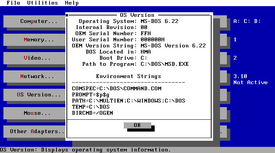- Microsoft Diagnostics
-
MSD (Microsoft Diagnostics) was a software tool developed by Microsoft, to assist in the diagnostics of 1990s era computers. The primary use of this tool was to provide detailed technical information about the user's software and hardware and then print the gathered information, usually to be used by support technicians in resolving user troubleshooting. The assumptions made by the program were valid until the late 1990s, when the common machines were DOS/Windows boxes with interrupts etc.: it does not handle plug and play USB, or other new technologies that appeared around 2000.
MSD first shipped with MS-Word for Windows, and was later included in Windows 3, MS-DOS 6, and on the Win9x cd-roms. Because OS/2 and Windows NT contain code forked from DOS at the DOS 5 level, the versions of MSD included here correspond to that of that era (i.e. version 2.0).
Windows NT 3 and 4 have
WinMSD, a program of similar features. However, the DOS/Windows specific functions were replaced by similar Windows NT concerns.WinMSDp.exe, included in the resource kits, provide the print functionality of MSD for WinMSD. Since NT 5 (2K), winmsd.exe has been a loader for msinfo32.exe.The program was usually started from the DOS Command Prompt using the command
MSD.EXE. Starting the program under a DOS window in either Windows or OS/2 shows only the DOS details allocated for that DOS session, not for the machine in general.Aspects of the system for which MSD provided technical information:
- Computer brand and processor information
- Memory (Total, EMS, and XMS)
- Video (Type such as VGA and manufacturer)
- Network
- Operating System versions
- Type of Mouse if installed
- Disk drives (and partitions), excluding CD-ROM drives etc.
- LPT ports
- COM ports
- IRQ status
- TSR programs
- Device drivers
- Other adapters
In PC-DOS 6 and above,
qconfig.exeprovides this functionality. Commercial alternatives include Manifestmft.exefrom Quarterdeck's QEMM.This program was replaced with
msinfo32.exe. This has similar features, but intended for more recent machines. It first appeared in MS-Word, and later was distributed with Plus! for Windows 95 and Windows 98. WinMSD became a loader for MSINFO32.See also
External links
Categories:- Discontinued Microsoft software
- DOS on IBM PC compatibles
Wikimedia Foundation. 2010.

